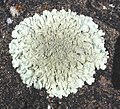Polar / sub-polar zone
The polar / sub-polar zone is one of the nine global eco-zones according to J. Schultz. Today it occupies about 14.8% of the earth's land surface. At the beginning of the 21st century, around 90% of this in the northern hemisphere and 100% in the southern hemisphere (the entire Antarctic) are largely in a natural state . Its expansion roughly coincides with the polar climate zone . According to the prevailing vegetation, it can be further subdivided into the landscape types ice shields , cold desert and tundra .
The boundaries of the polar / sub-polar zone are in reality fluid, so that an exact extent - as shown on the map - cannot in fact be determined. This fact becomes understandable if one uses comparable geozonal models , e.g. Some of them show significant deviations from each other (for example the comparable polar zonobiom on the map of the zonobiome according to Walter and Breckle or the FAO Ecozones ).
climate
The polar ecozone is characterized by the fact that it lies north of the 10 ° C July isotherm (areas with an average temperature in July below 10 ° C). Some areas, e.g. B. in the Antarctic, have summer average temperatures of −30 ° C and lower. Precipitation falls little, and then as snow.
Relief and weathering
Weathering processes are mainly characterized by frost, but also by thawing processes. Frost dynamic processes such as frost splintering , but also fluvial erosion processes caused by the melting of the snow cover, are responsible for weathering and changes in relief.
Floors
Cryosols (mineral permafrost soils ) predominate in the polar zone . Organic permafrost soils are also common; they are among the Cryic Histosolen . There are also Cambisole , Leptosole , Stagnosole or other soils with the Gelic Qualifier (= permafrost from a depth of at least 2 m). The soils are only weakly to moderately developed, as the soil-forming factors are unfavorable for stronger pedogenesis . For example, there is little or no bioturbation (rooting, worms) in the permafrost soil.
vegetation
Due to the ice and snow cover, the vegetation is only viable to a very limited extent. Nothing thrives in the ice desert in the heart of Greenland. The polar desert in the northernmost regions of Russia, Canada and Scandinavia is only covered by a tenth of the area of plants, whereas the Lower Arctic tundra is already 80% covered by vegetation. Trees do not occur (as north of the tree line ), but chamaephytes ( subshrubs ) Hemikryophyten and cryptophytes. The living conditions for the flora can be compared with the nival vegetation level of mountains.
Land use
There are very few permanent settlements in the polar zone. In the arctic tundra areas - and especially on the coasts - there are mainly indigenous ethnic groups such as the Eskimo peoples of North America, the Sami of Fennoscandia and the so-called small peoples of the Russian north such as the Nenets and Chukchi . In North America, hunting (for land and marine mammals) and fishing still traditionally play an important role in human subsistence . Agricultural use of the zone is not possible due to the climate. In Eurasia, however, mobile reindeer grazing developed centuries ago, which is the most important livelihood for many of the people who live there and which can be viewed as a form of extensive land use.
There are abundant natural resources in the earth which, with the exception of the gas and oil deposits in Siberia and Alaska, have so far only been extracted "selectively". Due to the extremely sensitive ecosystems of the far north, the extraction of mineral resources involves great risks. The construction of stone houses and traffic routes is problematic due to the frost dynamics (e.g. Thermokarst or Alasse). Added to this are the permafrost soils that are thawing due to global warming .
Picture gallery
Polar bears near North Pole
Iñupiat (1929)
See also
- Polar region
- Sub-polar zone (climatic zone)
Remarks
- ↑ Values from J. Schultz (Schultz, J. (2008): Die Ökozonen der Erde. Stuttgart) without Antarctica and Greenland converted to the entire land surface. See the article Eco zone # The individual eco zones .
-
↑ Map data for the studies Last of the wild , Intact forest landscapes and Review of status and conservation of wild land in Europe , summarized in the source description for the wilderness map on Wikimedia Commons
- Last of the Wild Project, Version 2, 2005 (LWP-2): Last of the Wild Dataset (Geographic). Palisades, NY: NASA Socioeconomic Data and Applications Center (SEDAC). Wildlife Conservation Society (WCS), and Center for International Earth Science Information Network (CIESIN) / Columbia University, 2005. Retrieved January 14, 2013. doi: 10.7927 / H4348H83
- Roadmap to Recovery: The world's last intact forest landscapes ( Memento from September 27, 2013 in the Internet Archive ) (PDF; 11.4 MB). Greenpeace International, Amsterdam 2006. Retrieved January 14, 2013
- REVIEW OF STATUS AND CONSERVATION OF WILD LAND IN EUROPE. FINAL REPORT. TENDER REF: CR / 2009/31. PROJECT NO: WRI / 001/09 (PDF; 4.7 MB) The Wildland Research Institute (WRI), 2009. Accessed January 14, 2013.
- ↑ See also tabular overview of various landscape zone models and their proportions ; (PDF, 114 kB)
Individual evidence
- ↑ a b c d e Schultz, J. (2008): The eco-zones of the earth . Stuttgart: Ulmer. ISBN 978-3-8252-1514-9
literature
- J. Schultz: The Earth's Eco Zones. Ulmer, Stuttgart 2016 (5th edition) ISBN 978-3-8252-4628-0
- J. Pfadenhauer, F. Kötzli: Vegetation of the earth. Springer Spectrum, Heidelberg 2014. ISBN 978-3-642-41949-2 .
- W. Zech, P. Schad, G. Hintermaier-Erhard: Soils of the world. 2nd Edition. Springer Spectrum, Heidelberg 2014. ISBN 978-3-642-36574-4 .







